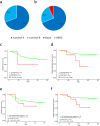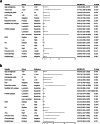Prognostic significance of different molecular typing methods and immune status based on RNA sequencing in HR-positive and HER2-negative early-stage breast cancer
- PMID: 35568835
- PMCID: PMC9107692
- DOI: 10.1186/s12885-022-09656-4
Prognostic significance of different molecular typing methods and immune status based on RNA sequencing in HR-positive and HER2-negative early-stage breast cancer
Abstract
Background: This study was conducted to evaluate the prognostic significance of different molecular typing methods and immune status based on RNA sequencing (RNA-seq) in hormone receptor (HR)-positive and human epidermal growth factor receptor 2 (HER2)-negative (HR + /HER2-) early-stage breast cancer and develop a modified immunohistochemistry (IHC)-based surrogate for intrinsic subtype analysis.
Methods: The gene expression profiles of samples from 87 HR + /HER2- early-stage breast cancer patients were evaluated using the RNA-seq of Oncotype Dx recurrence score (RS), PAM50 risk of recurrence (ROR), and immune score. Intrinsic tumor subtypes were determined using both PAM50- and IHC-based detection of estrogen receptor, progesterone receptor, Ki-67, epidermal growth factor receptor, and cytokeratins 14 and 5/6. Prognostic variables were analyzed through Cox regression analysis of disease-free survival (DFS) and distant metastasis-free survival (DMFS).
Results: Survival analysis showed that ROR better predicted recurrence and distant metastasis compared to RS (for DFS: ROR, P = 0.000; RS, P = 0.027; for DMFS, ROR, P = 0.047; RS, P = 0.621). Patients with HR + /HER2- early-stage breast cancer was classified into the luminal A, luminal B, HER2-enriched, and basal-like subtypes by PAM50. Basal-like subgroups showed the shortest DFS and DMFS. A modified IHC-based surrogate for intrinsic subtype analysis improved the concordance with PAM50 from 66.7% to 73.6%, particularly for basal-like subtype identification. High level of TILs and high expression of immune genes predicted poor prognosis. Multi-factor Cox analysis showed that IHC-based basal-like markers were the only independent factors affecting DMFS.
Conclusions: Prognosis is better evaluated by PAM50 ROR in early-stage HR + /HER2- breast cancer and significantly differs among intrinsic subtypes. The modified IHC-based subtype can improve the basal-like subtype identification of PAM50. High immunity status and IHC-based basal-like markers are negative prognostic factors.
Keywords: HR-positive/HER2-negative breast cancer; Immune rescore; Intrinsic subtype; Risk of recurrence; Tumor-infiltrating lymphocyte.
© 2022. The Author(s).
Conflict of interest statement
All authors report no conflict of interests.
Figures







Similar articles
-
Prognostic value of PAM50 and risk of recurrence score in patients with early-stage breast cancer with long-term follow-up.Breast Cancer Res. 2017 Nov 14;19(1):120. doi: 10.1186/s13058-017-0911-9. Breast Cancer Res. 2017. PMID: 29137653 Free PMC article.
-
Everolimus plus Exemestane for Hormone Receptor-Positive Advanced Breast Cancer: A PAM50 Intrinsic Subtype Analysis of BOLERO-2.Oncologist. 2019 Jul;24(7):893-900. doi: 10.1634/theoncologist.2018-0407. Epub 2019 Jan 24. Oncologist. 2019. PMID: 30679318 Free PMC article. Clinical Trial.
-
PAM50 breast cancer subtyping by RT-qPCR and concordance with standard clinical molecular markers.BMC Med Genomics. 2012 Oct 4;5:44. doi: 10.1186/1755-8794-5-44. BMC Med Genomics. 2012. PMID: 23035882 Free PMC article.
-
Clinical Implications of Breast Cancer Intrinsic Subtypes.Adv Exp Med Biol. 2025;1464:435-448. doi: 10.1007/978-3-031-70875-6_21. Adv Exp Med Biol. 2025. PMID: 39821037 Review.
-
Navigating precision: the crucial role of next-generation sequencing recurrence risk assessment in tailoring adjuvant therapy for hormone receptor-positive, human epidermal growth factor Receptor2-negative early breast cancer.Cancer Biol Ther. 2024 Dec 31;25(1):2405060. doi: 10.1080/15384047.2024.2405060. Epub 2024 Sep 20. Cancer Biol Ther. 2024. PMID: 39304993 Free PMC article. Review.
Cited by
-
Esr1 but Not CYP19A1 Overexpression in Mammary Epithelial Cells during Reproductive Senescence Induces Pregnancy-Like Proliferative Mammary Disease Responsive to Anti-Hormonals.Am J Pathol. 2023 Jan;193(1):84-102. doi: 10.1016/j.ajpath.2022.09.007. Epub 2022 Dec 1. Am J Pathol. 2023. PMID: 36464512 Free PMC article.
-
Advancing breast cancer subtyping: optimizing immunohistochemical staining classification with insights from real-world Taiwanese data.Am J Cancer Res. 2023 Nov 15;13(11):5719-5732. eCollection 2023. Am J Cancer Res. 2023. PMID: 38058819 Free PMC article.
-
The Bio-Diversity and the Role of Gut Microbiota in Postmenopausal Women with Luminal Breast Cancer Treated with Aromatase Inhibitors: An Observational Cohort Study.Pathogens. 2022 Nov 26;11(12):1421. doi: 10.3390/pathogens11121421. Pathogens. 2022. PMID: 36558756 Free PMC article.
-
Comprehensive Transcriptome Analysis Expands lncRNA Functional Profiles in Breast Cancer.Int J Mol Sci. 2024 Aug 2;25(15):8456. doi: 10.3390/ijms25158456. Int J Mol Sci. 2024. PMID: 39126025 Free PMC article.
-
Rare diagnosis of locally advanced triple‑negative breast cancer with paraneoplastic dermatomyositis: A case report and literature review.Oncol Lett. 2025 Apr 23;29(6):309. doi: 10.3892/ol.2025.15055. eCollection 2025 Jun. Oncol Lett. 2025. PMID: 40337602 Free PMC article.
References
-
- Lænkholm AV, Jensen MB, Eriksen JO, Rasmussen BB, Knoop AS, Buckingham W, Ferree S, Schaper C, Nielsen TO, Haffner T, et al. PAM50 risk of recurrence score predicts 10-year distant recurrence in a comprehensive Danish cohort of postmenopausal women allocated to 5 years of endocrine therapy for hormone receptor-positive early breast cancer. J Clin Oncol. 2018;36(8):735–740. doi: 10.1200/JCO.2017.74.6586. - DOI - PubMed
MeSH terms
Substances
Grants and funding
LinkOut - more resources
Full Text Sources
Medical
Research Materials
Miscellaneous

